Study on Adhesion Performance and Aging Strength Degradation Mechanism of SBS Modified Asphalt with Different Anti-Aging Additive
Abstract
:1. Introduction
2. Materials and Methods
2.1. Raw Materials
2.1.1. Asphalt
2.1.2. Modifiers
- (1)
- Graphene
- (2)
- Rubber powder
- (3)
- Petroleum resin
2.2. Preparation and Performance Evaluation of Composite Modified Asphalt
2.2.1. Composite Modified Asphalt Preparation Process
- (1)
- Graphene/SBS composite modified asphalt (G/SBSMA)
- (2)
- Crumb rubber/SBS composite modified asphalt (CR/SBSMA)
- (3)
- Petroleum resin/SBS composite modified asphalt (PR/SBSMA)
2.2.2. Asphalt Aging Test
2.3. Surface Free Energy Methods
- (1)
- Cohesion energy
- (2)
- Adhesion work
- (3)
- Exfoliated work
- (4)
- Energy ratio
3. Results and Analysis
3.1. Conventional Performance Evaluation
- (1)
- Conventional properties of graphene/SBS composite modified asphalt
- (2)
- Conventional performance of crumb rubber/SBS composite modified asphalt
- (3)
- Conventional performance of petroleum resin/SBS composite modified asphalt
3.2. Contact Angle
3.3. Cohesion Energy
3.4. Adhesion Work
3.5. Exfoliated Work
3.6. Energy Ratio
4. Conclusions
Author Contributions
Funding
Institutional Review Board Statement
Informed Consent Statement
Data Availability Statement
Conflicts of Interest
References
- Peng, Q.; Hao, Z.H.; Tan, Y.Q. Influence analysis of UV-aging on the properties of high elastic modified asphalt and mixture. Tech. Highw. Trans. 2020, 36, 32–37. [Google Scholar] [CrossRef]
- Arsalan, R.; Imran, K.; Faisal, T.R. Evaluation of Moisture Damage Potential in Hot Mix Asphalt Using Polymeric Aggregate Treatment. Materials 2022, 15, 5437. [Google Scholar]
- Li, X.; Wang, Y.M.; Wu, Y.L. Properties and modification mechanism of asphalt with graphene as modifier. Constr. Build. Mater. 2021, 272, 121919. [Google Scholar] [CrossRef]
- Liu, Z.H.; Jiang, W.; Wang, L. Effect of graphene on rheological properties of SBS modified bitumen. Highway 2022, 67, 76–82. [Google Scholar]
- Dong, X.Y. Research on Performance of Nano-Graphene Modified Asphalt. Master’s Thesis, Southeast University, Nanjing, China, 2021. [Google Scholar]
- Zeng, Q.; Liu, Y.R.; Liu, Q.C. Preparation and modification mechanism analysis of graphene oxide modified asphalts. Constr. Build. Mater. 2020, 238, 117706. [Google Scholar] [CrossRef]
- Wang, R.R.; Yue, M.J.; Xiong, Y.C. Experimental study on mechanism, aging, rheology and fatigue performance of carbon nanomaterial/SBS-modified asphalt binders. Constr. Build. Mater. 2021, 268, 121189. [Google Scholar] [CrossRef]
- Liu, K.F.; Zhu, J.C.; Wu, C.F. Experimental study on aging resistance of graphene oxide modified asphalt and its mixture. Highway 2020, 65, 225–230. [Google Scholar]
- Bolakar, T.H. Production and characterisation of waste tire pyrolytic oil—Investigating physical and rheological behaviour of pyrolytic oil modified asphalt binder. Heliyon 2023, 9, e12851. [Google Scholar]
- Pouranian, M.R.; Notani, M.A.; Tabesh, M.T. Rheological and environmental characteristics of crumb rubber asphalt binders containing non-foaming warm mix asphalt additives. Constr. Build. Mater. 2020, 238, 117707. [Google Scholar] [CrossRef]
- Fernández, I.R.; Cavalli, M.C.; Poulikakos, L. Recyclability of Asphalt Mixtures with Crumb Rubber Incorporated by Dry Process: A Laboratory Investigation. Materials 2020, 13, 2870. [Google Scholar] [CrossRef]
- Suo, L.J. Preparation and properties of rubber powder/SBS composite modified asphalt binder. Funct. Mater. 2022, 53, 6224–6229. [Google Scholar]
- Jamal, M.; Giustozzi, F. Enhancing the asphalt binder’s performance against oxidative ageing and solar radiations by incorporating rubber from waste tyres. Constr. Build. Mater. 2022, 350, 128803. [Google Scholar] [CrossRef]
- Li, S.P.; Li, Y.F.; Chen, J. Study on the rheological properties and performance of rubber and RET modified SBS asphalt before and after aging. Highw. Eng. 2017, 42, 112–120. [Google Scholar]
- Xiang, L.; Cheng, J.; Kang, S.J. Thermal oxidative aging mechanism of crumb rubber/SBS composite modified asphalt. Constr. Build. Mater. 2015, 75, 169–175. [Google Scholar] [CrossRef]
- Ren, M.K.; Li, Y.M.; Cheng, P.F. Effect of modifier on low-temperature reversible aging behavior of asphalt binder and its morphology analysis. Constr. Build. Mater. 2022, 351, 128943. [Google Scholar] [CrossRef]
- Akihiro, M.; Toshiro, J.; Takaaki, N. Construction and pavement properties after seven years in porous asphalt with long life. Constr. Build. Mater. 2014, 50, 401–413. [Google Scholar]
- Cao, D.W.; Lu, J.; Zhang, H.Y. Contrastive on performance of fully permeable asphalt pavement dedicated high-viscosity modified asphalt. J. Chang’an Univ. 2019, 39, 21–28. [Google Scholar]
- Sun, G.Q.; Zhu, X.B.; Zhang, Q.Y. Oxidation and polymer degradation characteristics of high viscosity modified asphalts under various aging environments. Sci. Tot. Env. 2022, 813, 152601. [Google Scholar] [CrossRef]
- Qiu, X.; He, L.Y.; Chen, J. Diagnostic of aging resistance and storage stability of high-performance modified asphalts under multi-scale conditions. J. Zhejiang Norm. Univ. 2023, 46, 169–178. [Google Scholar] [CrossRef]
- Shi, J.T.; Zhao, P.H.; Fan, W.Y. Facile preparation and application performance evaluation of SBS/C 9 petroleum resin blends as modifier for high viscosity asphalt. Constr. Build. Mater. 2020, 262, 120073. [Google Scholar] [CrossRef]
- Yang, J.H.; Zhang, Z.Q.; Shi, J.R. Comparative analysis of thermal aging behavior and comprehensive performance of high viscosity asphalt (HVA) from cohesion, adhesion and rheology perspectives. Constr. Build. Mater. 2022, 317, 125982. [Google Scholar] [CrossRef]
- JTG E20-2011; Standard Test Methods of Bitumen and Bituminous Mixtures for Highway Engineering. People’s Communications Press: Beijing, China, 2011.
- Yerik, A.; Aidos, Y.; Assel, N. Characterization of asphalt bitumens and asphalt concretes modified with carbon powder. Case Stud. Constr. Mater. 2022, 17, e01554. [Google Scholar]
- Jihyeon, Y.; Mithil, M.; IlHo, N. Evaluation of Effect of Thermoplastic Polyurethane (TPU) on Crumb Rubber Modified (CRM) Asphalt Binder. Materials 2022, 15, 3824. [Google Scholar]
- Student, M.M.; Pokhmurs’ka, H.V.; Zadorozhna, K.R. Corrosion Resistance of VC–FeCr and VC–FeCrCo Coatings Obtained by Supersonic Gas-Flame Spraying. Mater. Sci. 2019, 54, 535–541. [Google Scholar] [CrossRef]
- Reza, B.; Dariush, S.; Mahmoud, A. Correlation between bond strength and surface free energy parameters of asphalt binder-aggregate system. Constr. Build. Mater. 2021, 303, 124487. [Google Scholar]
- Naseri, Y.M.; Sarkar, A.; Hamedi, G.H. Application of the surface free energy method on the mechanism of low-temperature cracking of asphalt mixtures. Constr. Build. Mater. 2020, 268, 121194. [Google Scholar] [CrossRef]
- Shu, S.Q. Study on the Improvement of Adhesion between Granite and Asphalt and the Road Performance of Mixture. Master’s Thesis, Shandong Jianzhu University, Jinan, China, 2022. [Google Scholar]
- JTG F40-2004; Technical Specifications for Construction of Highway Asphalt Pavement. People’s Communications Press: Beijing, China, 2004.
- Zhang, W.G.; Qiu, L.; Liu, J.P. Modification mechanism of C9 petroleum resin and its influence on SBS modified asphalt. Constr. Build. Mater. 2021, 306, 124740. [Google Scholar] [CrossRef]
- Emiliano, P.; Edoardo, B. A Review on Bitumen Aging and Rejuvenation Chemistry: Processes, Materials and Analyses. Sustainability 2021, 13, 6523. [Google Scholar]
- Ilyin, S.O.; Kostyuk, A.V.; Ignatenko, V.Y. The Effect of Tackifier on the Properties of Pressure-Sensitive Adhesives Based on Styrene–Butadiene–Styrene Rubber. Russ. J. Appl. Chem. 2018, 91, 1945–1956. [Google Scholar] [CrossRef]
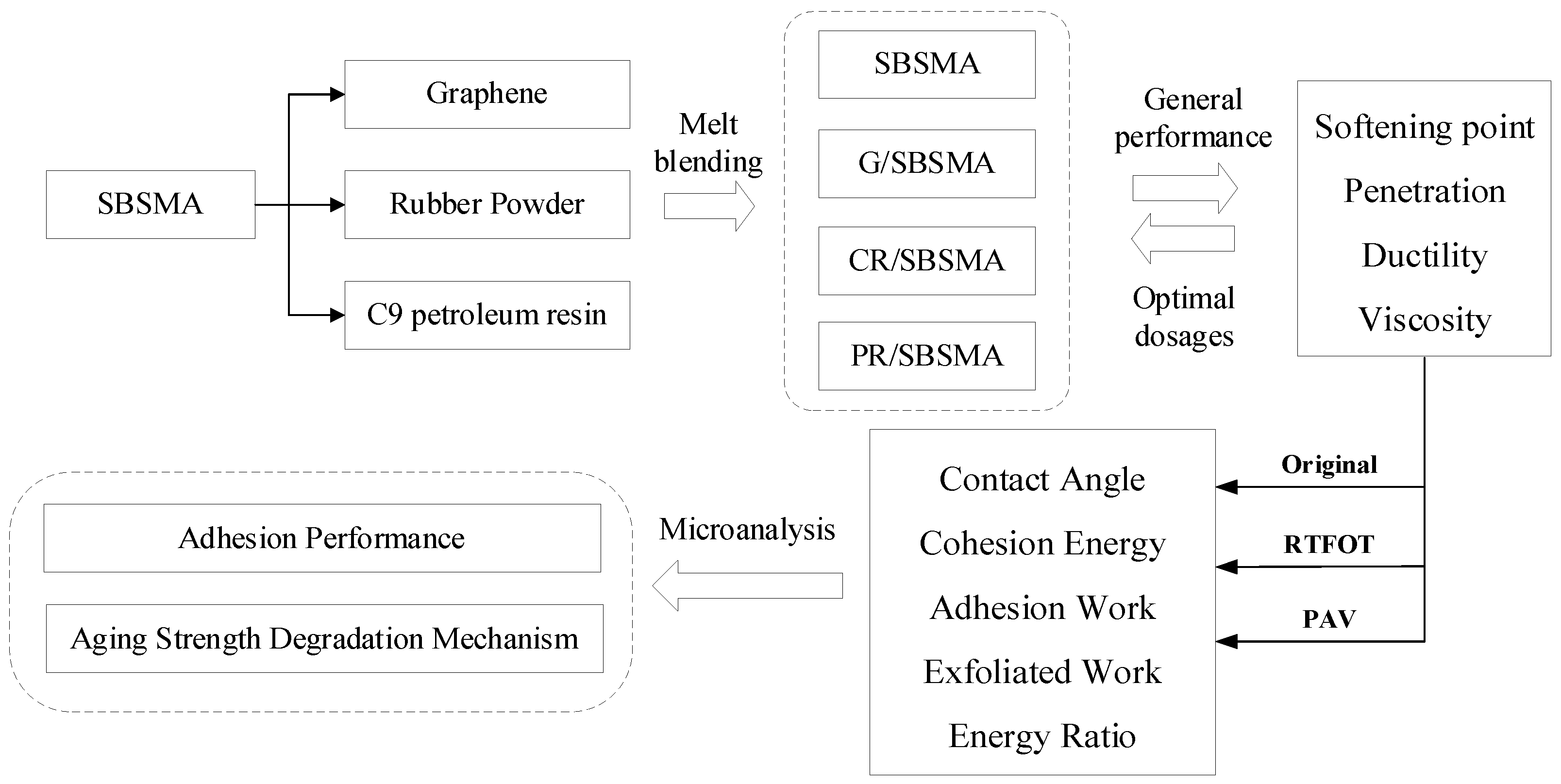

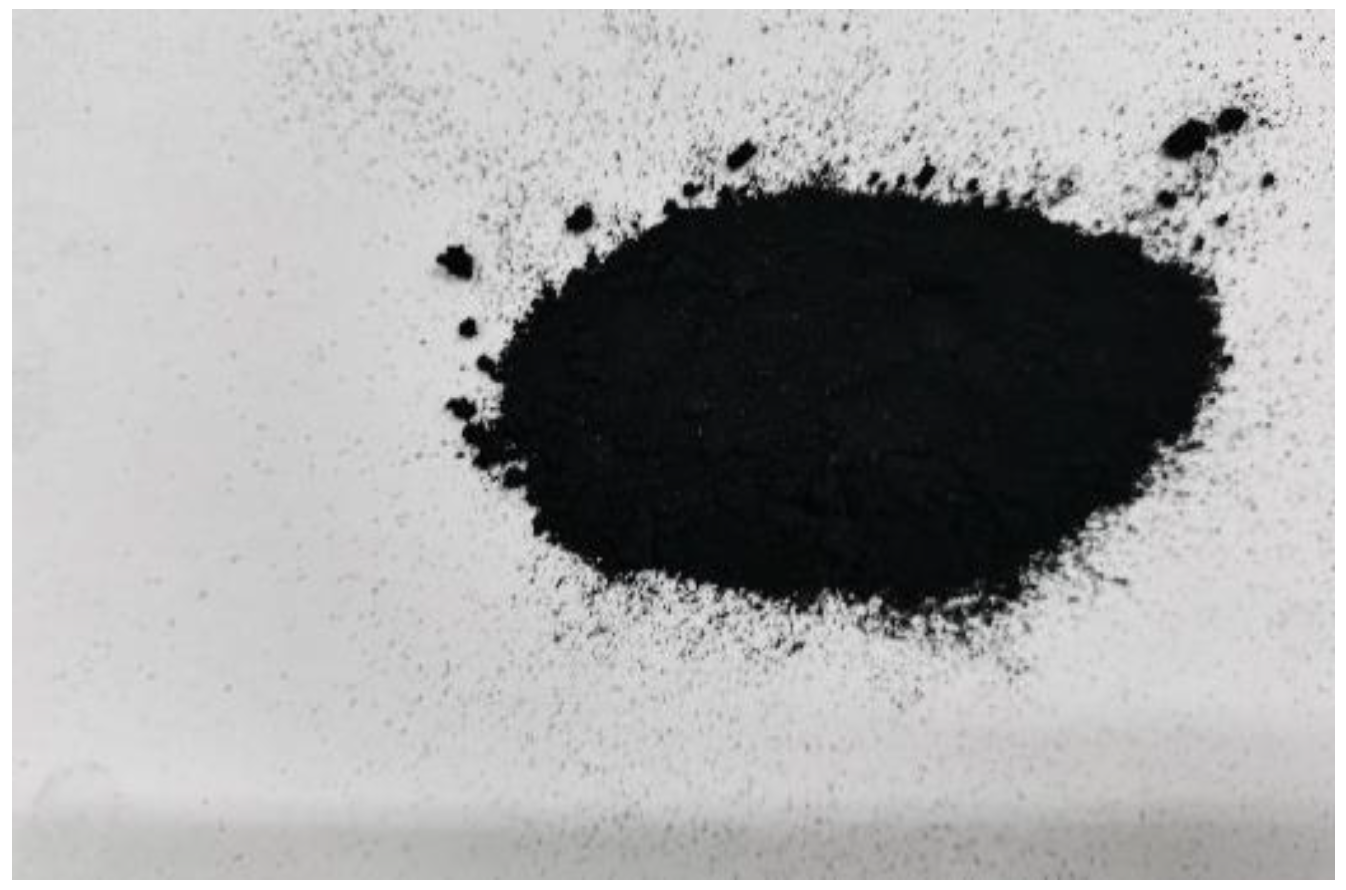



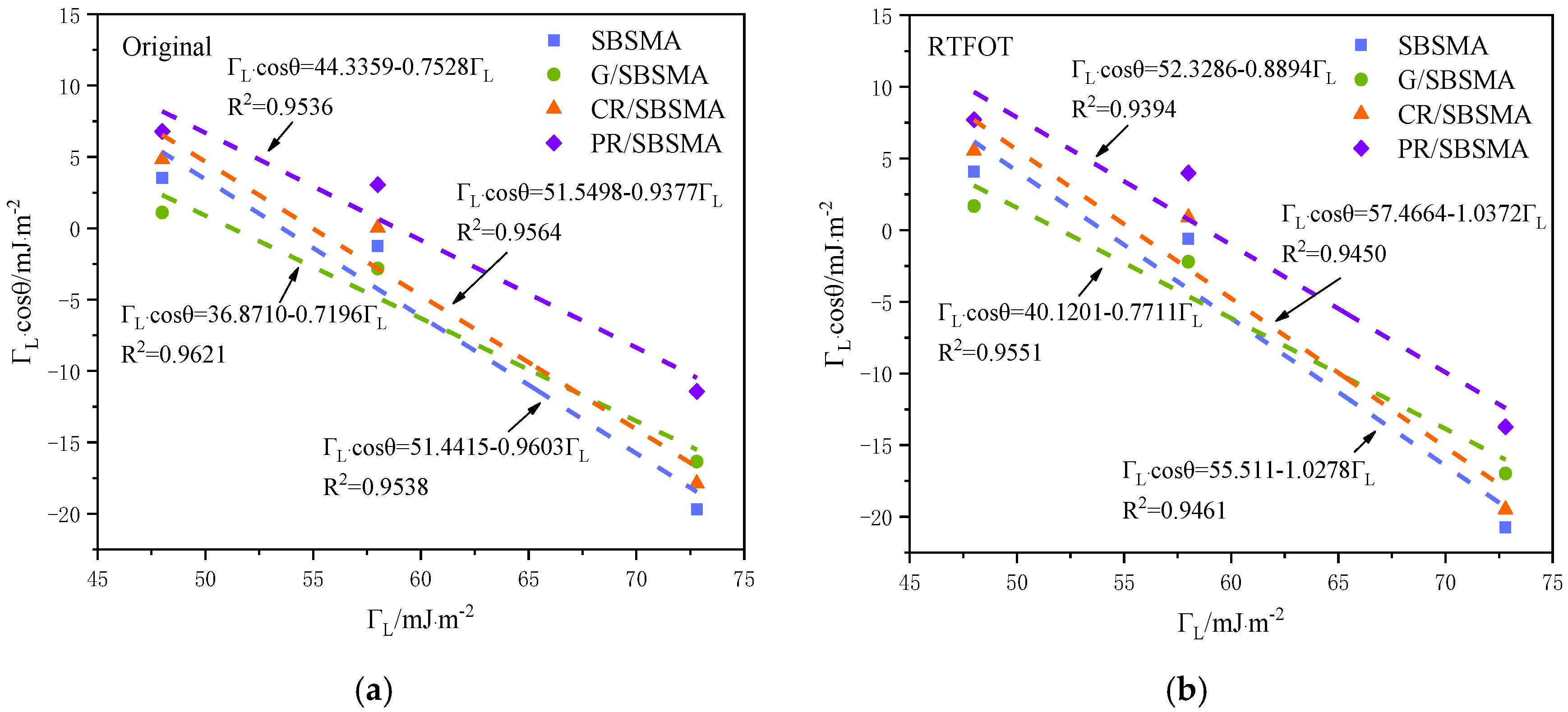
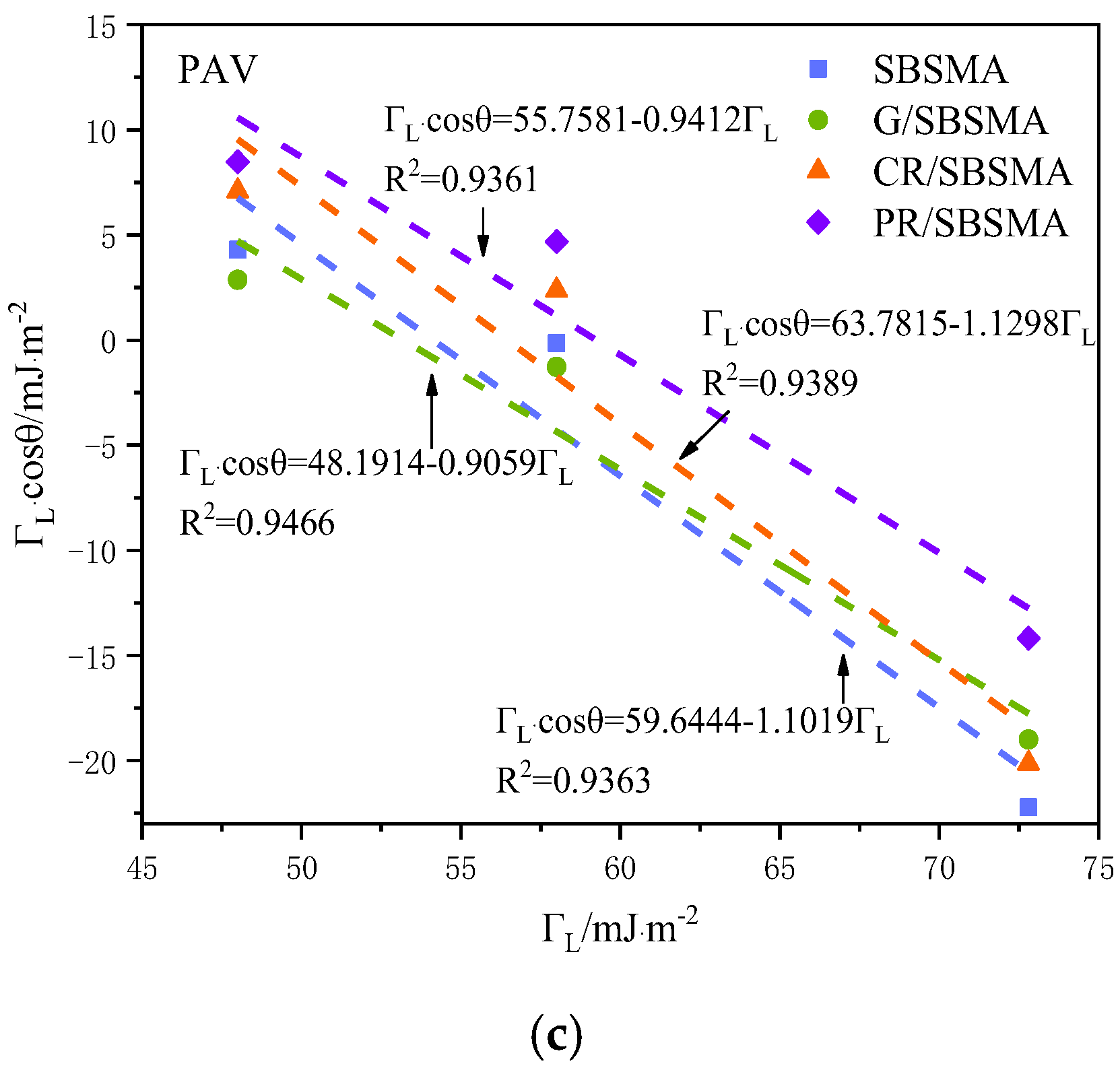

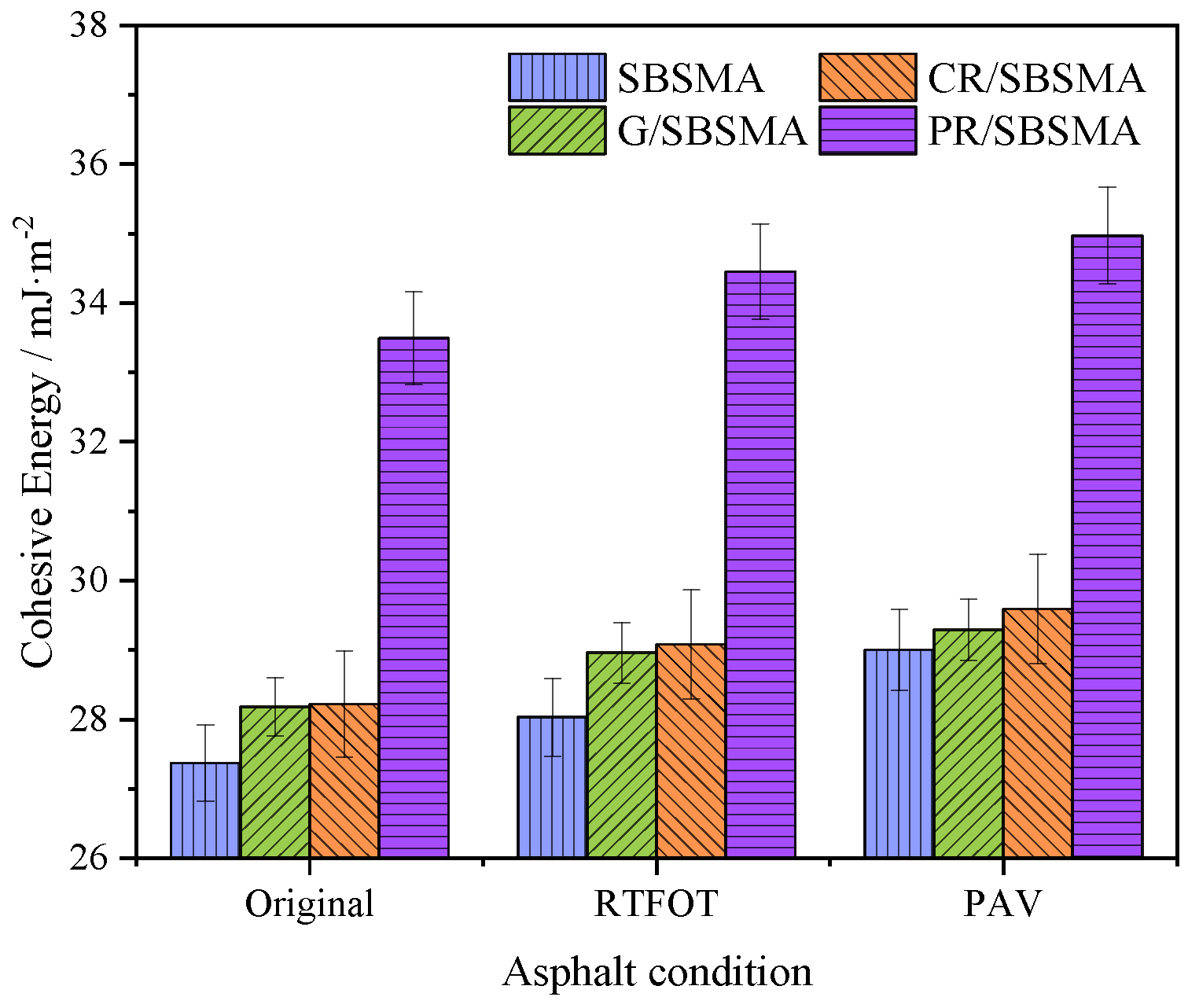
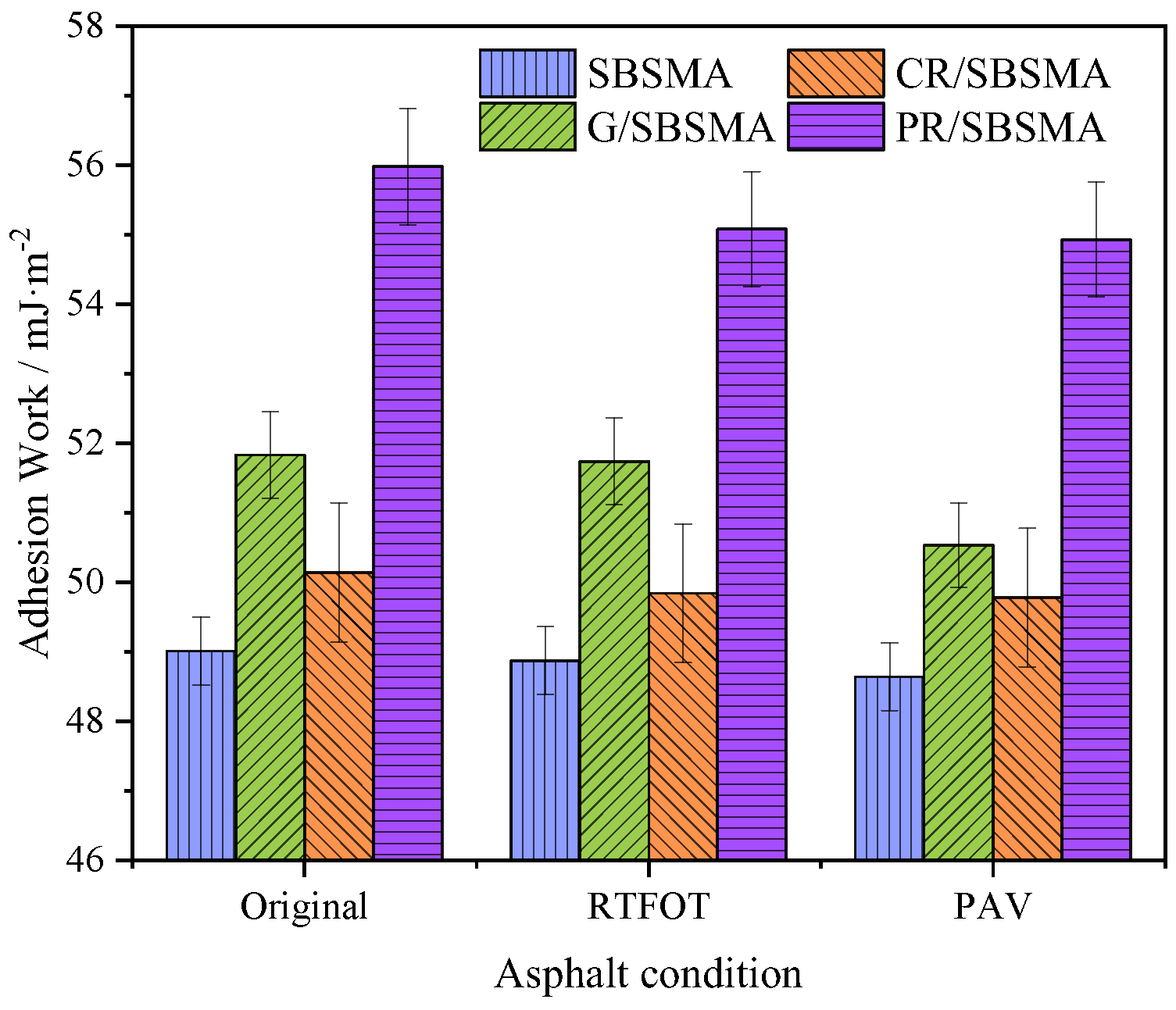
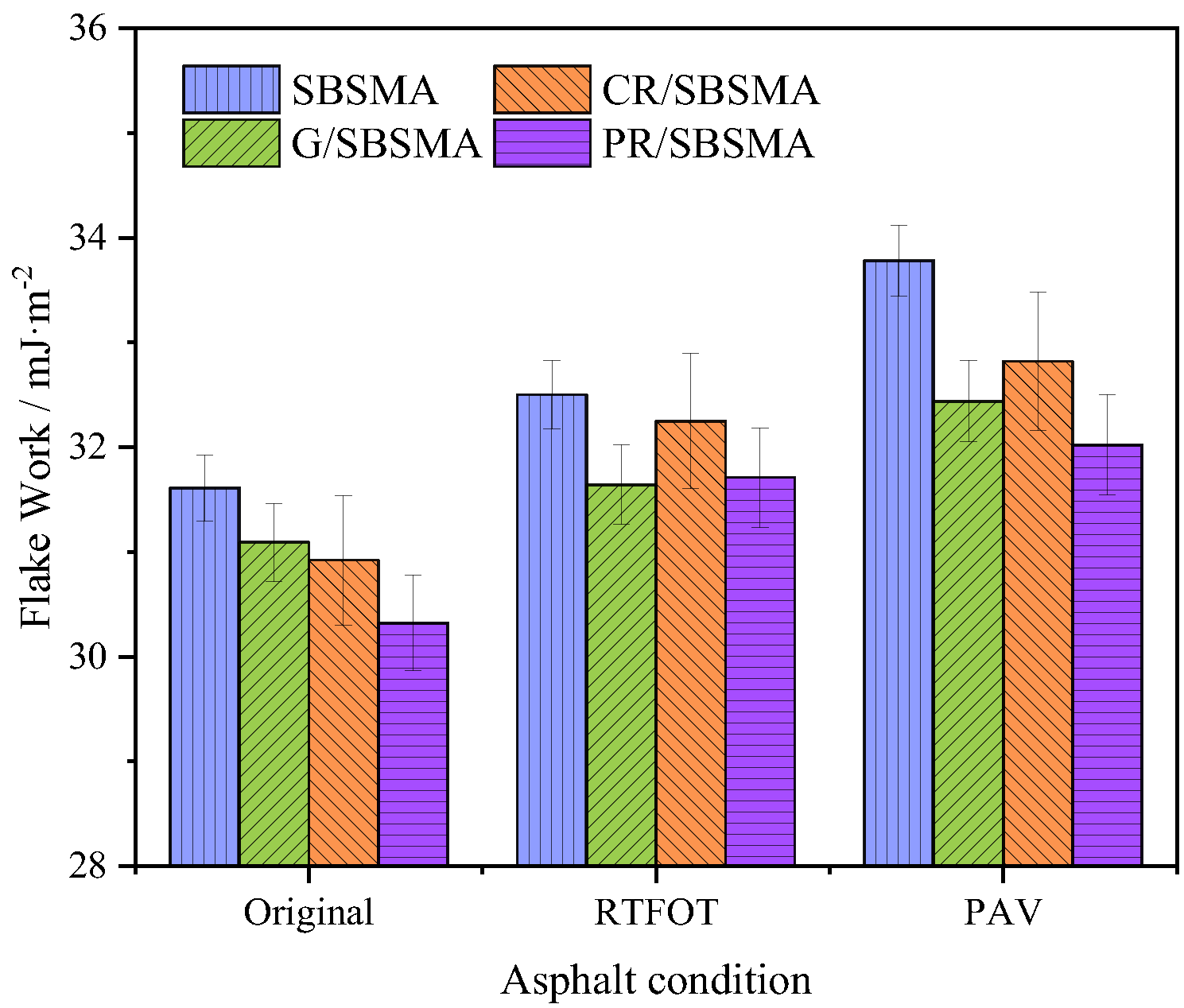
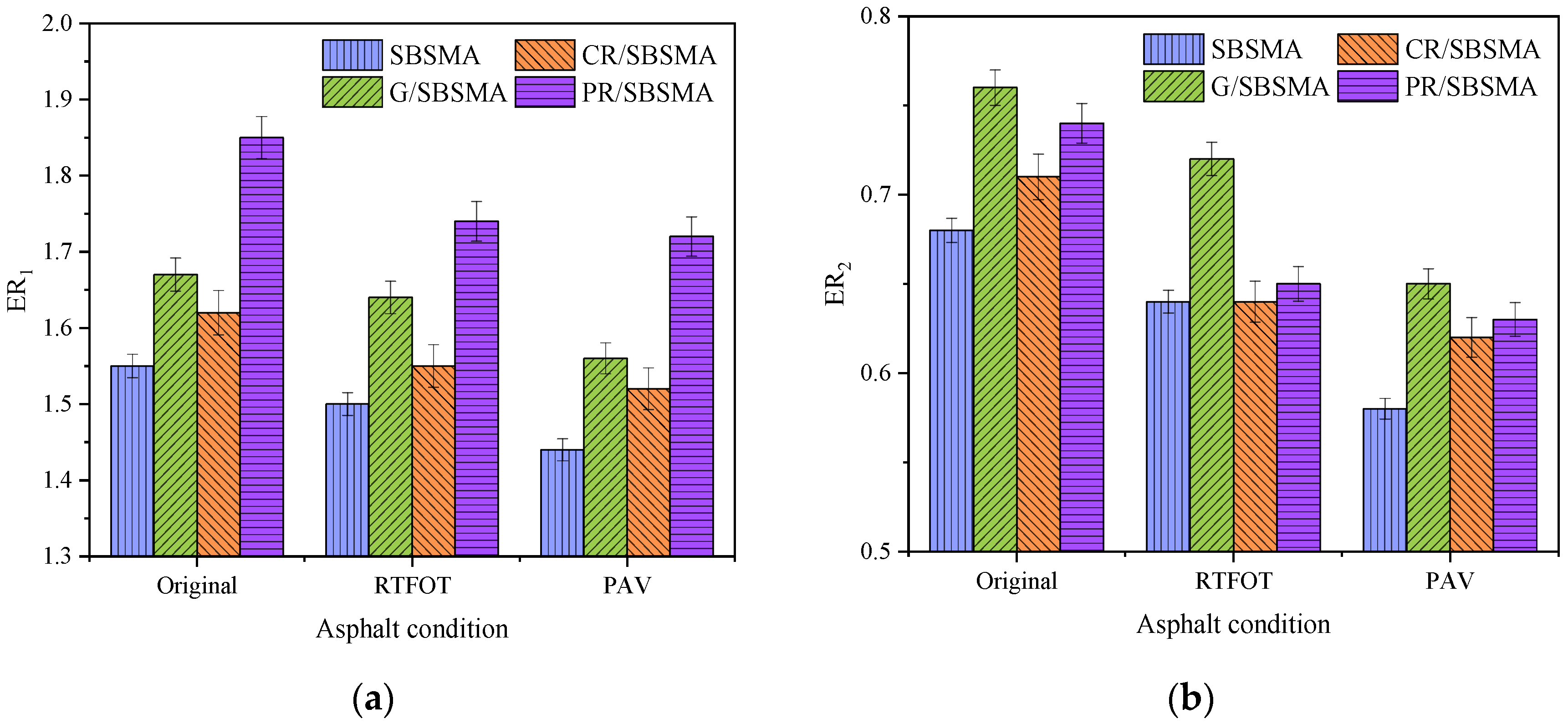
| Index | Detection Results | Technical Requirement | Test Method |
|---|---|---|---|
| 25 °C Penetration/0.1 mm | 52.5 | 40–60 | T0604 |
| Penetration index PI | 0.15 | ≮0 | T0604 |
| 5 °C Ductility/cm | 31.6 | ≮20 | T0606 |
| Softening point/°C | 72.8 | ≮60 | T0620 |
| 135 °C Viscosity/(Pa·s) | 1.53 | ≯3 | T0605 |
| 25 °C Elastic recovery/% | 83 | ≮75 | T0611 |
| 15 °C Density/(g·cm−3) | 1.038 | Actual observation record | T0603 |
| Appearance | Number of Layers /Layers | Thickness /nm | Specific Surface Area/(m2·g−1) | Lamellar Diameter/μm | Oxygen Content/% | Sulphur Content/% |
|---|---|---|---|---|---|---|
| Black powder | 6–10 | 3.4–8 | 100–300 | 5~50 | 0.5 | 0.5 |
| Appearance | Relative Density | Moisture Content/% | Rubber Hydrocarbon Content/% | Acetone Extract/% | Carbon Black Mass Fraction/% |
|---|---|---|---|---|---|
| Black powder | 1.16 | 0.55 | 58.2 | 7.9 | 32.8 |
| Appearance | Relative Density | Refractive Index | Acid Value | Softening Point/°C | Wax Fog Point/°C |
|---|---|---|---|---|---|
| Yellow granules | 0.98 | 1.512 | ≤0.5 | 110 | 78 |
| Type of Test Solution | ΓL | ||||
|---|---|---|---|---|---|
| Formamide | 58.0 | 39.0 | 19.0 | 2.28 | 39.6 |
| Glycol | 48.0 | 29.0 | 19.0 | 1.92 | 47.0 |
| Distilled water | 72.8 | 21.8 | 51.0 | 25.5 | 25.5 |
| Type of Aggregate | ΓS | ||||
|---|---|---|---|---|---|
| Limestone | 46.24 | 28.67 | 17.57 | 9.23 | 8.36 |
| Index | Graphene Content | Technical Requirement | |||||
|---|---|---|---|---|---|---|---|
| 0% | 0.5% | 1% | 1.5% | 2% | 2.5% | ||
| Softening point/°C | 72.8 | 74.1 | 75.3 | 76.3 | 77.2 | 77.9 | ≮60 |
| 25 °C Penetration/0.1 mm | 52.5 | 51.2 | 50 | 48.8 | 48.2 | 46.8 | 40~60 |
| 5 °C Ductility/cm | 31.6 | 32.1 | 32.4 | 32.7 | 32.8 | 31.5 | ≮20 |
| 135 °C Viscosity/(Pa·s) | 1.53 | 1.68 | 1.71 | 1.82 | 1.92 | 1.99 | ≯3 |
| Index | Rubber Powder Content | Technical Requirement | |||||
|---|---|---|---|---|---|---|---|
| 0% | 10% | 12.5% | 15% | 17.5% | 20% | ||
| Softening point/°C | 72.8 | 70.2 | 71.8 | 72.8 | 73.2 | 73.5 | ≮60 |
| 25 °C Penetration/0.1 mm | 52.5 | 55.2 | 54.5 | 53.5 | 50.6 | 45.3 | 40~60 |
| 5 °C Ductility/cm | 31.6 | 33.1 | 33.7 | 34.2 | 34.5 | 33 | ≮20 |
| 135 °C Viscosity/(Pa·s) | 1.53 | 1.91 | 2.06 | 2.29 | 2.38 | 2.46 | ≯3 |
| Index | Petroleum Resin Content | Technical Requirement | |||||
|---|---|---|---|---|---|---|---|
| 0% | 3% | 4% | 5% | 6% | 7% | ||
| Softening point/°C | 72.8 | 75.3 | 78.2 | 80 | 81.5 | 82.2 | ≮60 |
| 25 °C Penetration/0.1 mm | 52.5 | 49.9 | 49.2 | 48.7 | 48.3 | 48.1 | 40~60 |
| 5 °C Ductility/cm | 31.6 | 34.6 | 35.9 | 37.5 | 36.8 | 35.5 | ≮20 |
| 135 °C Viscosity/(Pa·s) | 1.53 | 2.05 | 2.27 | 2.53 | 2.71 | 2.85 | ≯3 |
| Asphalt Type | Aging Condition | Formamide /° | Coefficient of Variation/% | Glycol/° | Coefficient of Variation/% | Distilled Water/° | Coefficient of Variation/% |
|---|---|---|---|---|---|---|---|
| SBSMA | Original | 91.22 | 1.88 | 85.77 | 1.55 | 105.69 | 1.79 |
| RTFOT | 90.58 | 1.52 | 85.12 | 2.41 | 106.54 | 1.46 | |
| PAV | 90.15 | 2.23 | 84.86 | 1.95 | 107.78 | 1.55 | |
| G/SBSMA | Original | 92.79 | 1.44 | 88.68 | 2.63 | 102.97 | 0.88 |
| RTFOT | 92.18 | 2.51 | 87.99 | 3.62 | 103.49 | 1.64 | |
| PAV | 91.25 | 1.38 | 86.57 | 2.44 | 105.13 | 1.94 | |
| CR/SBSMA | Original | 89.97 | 3.76 | 84.22 | 2.85 | 104.21 | 3.23 |
| RTFOT | 89.12 | 2.92 | 83.37 | 3.65 | 105.53 | 2.08 | |
| PAV | 87.65 | 3.55 | 81.51 | 3.44 | 106.05 | 3.11 | |
| PR/SBSMA | Original | 86.99 | 3.05 | 81.88 | 2.56 | 99.03 | 2.15 |
| RTFOT | 86.07 | 2.87 | 80.75 | 2.08 | 100.86 | 1.88 | |
| PAV | 85.36 | 2.55 | 79.82 | 1.92 | 101.23 | 2.07 |
Disclaimer/Publisher’s Note: The statements, opinions and data contained in all publications are solely those of the individual author(s) and contributor(s) and not of MDPI and/or the editor(s). MDPI and/or the editor(s) disclaim responsibility for any injury to people or property resulting from any ideas, methods, instructions or products referred to in the content. |
© 2023 by the authors. Licensee MDPI, Basel, Switzerland. This article is an open access article distributed under the terms and conditions of the Creative Commons Attribution (CC BY) license (https://creativecommons.org/licenses/by/4.0/).
Share and Cite
Zhuang, C.; Guo, H.; Li, F.; Hao, Y.; Chen, K.; Li, G.; Ye, Y. Study on Adhesion Performance and Aging Strength Degradation Mechanism of SBS Modified Asphalt with Different Anti-Aging Additive. Materials 2023, 16, 4881. https://doi.org/10.3390/ma16134881
Zhuang C, Guo H, Li F, Hao Y, Chen K, Li G, Ye Y. Study on Adhesion Performance and Aging Strength Degradation Mechanism of SBS Modified Asphalt with Different Anti-Aging Additive. Materials. 2023; 16(13):4881. https://doi.org/10.3390/ma16134881
Chicago/Turabian StyleZhuang, Chuanyi, Hao Guo, Fengxiang Li, Yan Hao, Kun Chen, Gen Li, and Yali Ye. 2023. "Study on Adhesion Performance and Aging Strength Degradation Mechanism of SBS Modified Asphalt with Different Anti-Aging Additive" Materials 16, no. 13: 4881. https://doi.org/10.3390/ma16134881





